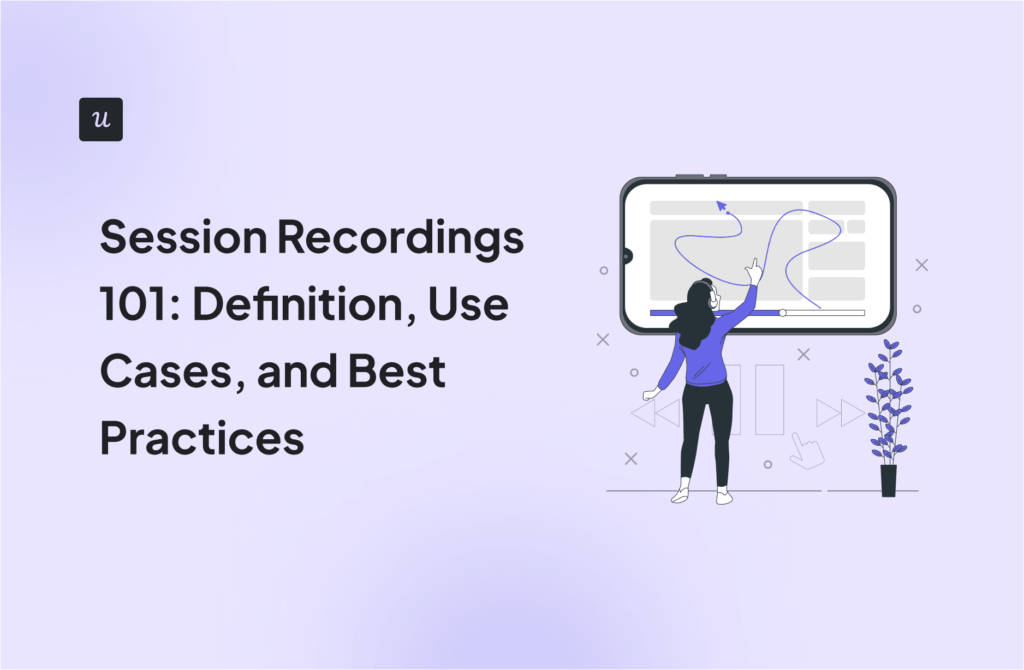![Micro Goals vs Macro Goals in Product Marketing [Examples Included] cover](https://blog-static.userpilot.com/blog/wp-content/uploads/2022/08/Micro-Goals-vs-Macro-Goals-in-Product-Marketing_1d31a5985c560c6feb8b94cf289e9f36_2000.png)
Micro goals vs macro goals in product marketing: Have you ever wondered what the difference is and how can you use both to achieve customer success and product growth?
As a product marketing manager, you need to set goals that would guide and motivate you and your team members. You need to take both small and big actions to impress your customers through their journey and retain them.
So let’s see how micro and macro goals can make all the difference in your product marketing.
Try Userpilot Now
See Why 1,000+ Teams Choose Userpilot

Micro Goals vs Macro Goals in Product Marketing (short summary)
- A macro goal is considered the primary goal of your SaaS product.
- A micro goal is a particular action or a set of actions that lead to macro conversions.
- Micro goals can help you get insights into user behavior, identify friction areas, and find the highest-performing channels. The macro goals of your business help you track success, know whether you have reached major milestones, and understand the overall financial situation of your company.
- Examples of micro goals include understanding your audience, determining your product proposition and messaging, and improving your PQL conversion rate.
- Examples of macro goals include increasing product adoption, reducing churn, and product internationalization.
- Userpilot allows you to set up custom goals, monitor progress toward these goals, and track the macro and micro conversions.
What is a macro goal in product marketing?
A macro goal is the primary objective of your SaaS business. Such goals require big conversions, i.e converting from a trial or freemium to a paid account.
What is a micro goal in product marketing?
A micro goal is a specific action or set of actions that a customer takes to undergo a macro conversion. In other words, micro goals are small steps that end up fulfilling the main goal.

Why are both macro and micro goals important in product marketing?
Here’s why micro and macro conversions are equally important for your business.
Micro goals help you by:
- Giving insights into user behavior: Different customers use your product for different purposes. Micro goals help you understand the various user characteristics or behavior as well as identify patterns among the different groups.
- Identifying friction points: Micro goals enable you to know where customers are facing problems and take steps to improve their user experience. For example, if a customer gets stuck somewhere in the onboarding flow, you can improve your onboarding by providing in-app guidance like interactive walkthroughs.
- Monitoring the conversion funnel and identifying the highest-performing channels: Micro conversions are perfect for finding the primary sources of such conversions that let you build the customer journey. You can give direction to new users to push them forward in their journey and hence improve the macro conversion rates.
On the other hand, macro goals help you by:
- Making you see the bigger picture: You need to establish a common vision in order to define a macro goal and get a broader view of your product.
- Tracking success: How well are your digital marketing or product growth strategies performing compared to your past performances or your competitors? Macro goals give you quantitative measures of success. You can set key performance indicators for your marketing campaign or product.
- Letting you know if you reach big milestones: It is not only important to keep an eye out for these milestones, but also to learn how to reach them and keep track of your progress.
Micro goals vs macro goals
Macro goals are major milestones, while micro goals are smaller conversions that help achieve the main goal. There’s no competition between the two. Rather, you need to figure out when and how to apply each type of goal for the success of your organization.
Micro conversions include process milestones that directly lead to purchases, such as:
- Visiting your website’s pricing page.
- Browsing through several website pages.
- Signing up for a trial run.
Certain secondary actions can also be considered micro conversions if they improve the chances of a user returning and purchasing your product later. These include actions like signing up for the company newsletter.
The macro conversion would occur when all of these actions ultimately lead to the macro goal.

Micro goals examples
For a PMM leader, micro goals should focus on creating the market strategy (of course, these will depend on the state of product marketing in your organization or the stage of your product).
Here are 3 examples of micro goals that can lead you toward your primary goal.
- Understanding your audience (the different user personas).
- Nailing the value proposition.
- Improving marketing qualified lead (MQL) to sales qualified lead (SQL) or the product qualified lead (PQL) conversion rate.
Now let’s go deeper.
Understanding your audience
Not all of your customers will have the same goals or exhibit the same type of behavior. This makes it critical for you to create separate personas to better understand your audience.
You need to learn about each user persona thoroughly. User personas will allow you to fully understand why they’re working to achieve a certain goal.
The more you understand the customers, the more your brand’s messaging will resonate with them.
Additionally, user personas allow you to focus on specific pain points. For instance, you can decrease your customer acquisition cost by working on the channels where your target user persona spends most of the time.
The more you remove friction points and improve the customer experience, the more users will experience the value of your product. This, in turn, will reduce churn and boost your conversion rates.

Building a user persona is not a one-time thing. Instead, you need to collect data continuously. Let’s look at the example in the image above.
Start with the jobs to be done, as it helps to clarify the end goals the customer hopes to achieve with your product.
When determining the jobs to be done go through the various use cases of your product. It helps you to empathize with the customer better.
Note down the user’s company and team collaboration details. In addition, pay close attention to their pains or challenges and identify the ways your product can provide value to the customer.
Nailing product positioning and messaging
Product positioning is not only about what your product does and for whom, but also how you communicate these things to your target audience. Using the right words will make people understand what your brand is all about.
Your product positioning should identify the core values of your product and its competitive advantage. This sets clear expectations for the product marketing team right from the start of the campaign.
Moreover, this enables potential customers to clearly understand your product’s offering and its unique selling proposition as opposed to competitors. So they are unlikely to get disappointed once they use your product.
Getting the positioning right takes time. Even Zendesk and Slack had to use multiple iterations to get where they are now.
For your positioning strategy to be effective, you should:
- Ascertain your existing brand positioning at first.
- Find out your competitors and fully understand their brand positioning.
- Compare yours with that of your competitors to find areas of improvement.
- If changes are needed, brainstorm and come up with a value-based positioning idea that showcases your brand’s uniqueness.
- Determine your positioning statement to send a clear message to your target audience.
Furthermore, you should develop a messaging strategy to convey your brand’s messages. It should be aligned with your customer’s needs and goals to increase your brand’s awareness.

Strategic messaging should be personalized for a particular target audience. Therefore, you should create separate user personas before defining the strategy.
Customers move through multiple touchpoints throughout the user journey. Therefore, design the strategy in a way that addresses customers’ needs at every stage of the journey to meet their expectations.
Improving product qualified leads (PQL) conversions
What is a product qualified lead? Well, it actually varies from one business to another. Your product needs to have specific activation benchmarks that a user must reach to be classified as a PQL.
To find your PQL benchmarks, check the activities of the customers who have upgraded to a paid plan. For example, Dropbox classifies those free trial users as PQLs who upload a file within 1 hour of signing up.
However, there are 3 things all PQLs have in common.
- They have shown interest in purchasing your product.
- They match a customer profile.
- They have experienced your product’s value.

Here are 5 tactics you can use to improve PQL conversion for your product.
- Your prospects are more likely to subscribe to a paid plan if their in-app experiences are personalized. Thus, you should use personalized onboarding to help users reach the activation point. For instance, use a welcome screen to collect user information and segment them to offer relevant content.
- Use interactive walkthroughs to provide step-by-step guides on how to use the core features and boost your feature adoption rates.
- Offer in-app self-service support so that users can fix certain issues quickly on their own and reach activation faster.
- Send contextual in-app messages to keep users engaged.
- Gather customer feedback to get actionable insights into conversion rate optimization.
Macro goals examples
Now let’s have a look at some macro goals examples.
Here are 3 examples:
- Increasing product adoption
- Reducing churn
- Internationalizing and going global
Increase product adoption
Product adoption occurs when users use your product without looking for substitutes to meet their needs. They become active users because they receive continuous value from your product.
To improve product adoption, you need to drive customer stickiness. These are customers who stick around and keep investing in your product discover new functionalities and ultimately become brand advocates.
The image below shows an example of a feature adoption funnel.

You need progressive onboarding flows to get there. Progressive onboarding contextually helps customers learn more about a product as they engage with it.
Personalize every step of the customer experience to remove friction and drive value fast. Provide end-user training to educate your users on your product. This boosts product engagement and improves customer satisfaction.
Furthermore, you can use a product adoption platform that offers advanced segmentation. This helps to personalize the user experience and drive users to adoption by highlighting relevant features.
With Userpilot, you can segment users that match some specific conditions to create onboarding flows for them.

Reduce churn
Churn is inevitable for SaaS businesses. It may be due to a lack of customer fit, which means they weren’t the right customers for your product. You can also fail to find the right product-market fit, which means your product keeps drawing users but fails to meet market needs.
Ultimately, your goal is to nail both and decrease churn by having a product that attracts the right customer and offers value. This ensures long-term retention.
Here are some tactics for you to reduce churn.
Use churn surveys during offboarding to understand why your customers are leaving. This will allow you to make necessary improvements and offer alternative options like pausing their accounts.

Moreover, use PMF surveys to know whether you have product-market fit. If 40% of customers say they will miss your product, you have a product-market fit. You need to measure PMF continually in case there’s some big shift in the market.

Product internationalization: expanding and going global
Product internalization involves moving upmarket, positioning the product at a higher value, and attracting enterprise customers. These are macro goals that PMMs look into once the product is in the growth stage.
Going global and offering the product in different markets is a critical macro goal. You can’t simply take the product and open up subscriptions from different parts of the world. Sometimes you may even have to change the product and offer different features in different regions.
Watch the video below as Gernot Schwendtner, the co-founder and CEO of weGrow International talks about how their company expanded internationally.
How to set up and track micro and macro goals with Userpilot?
Creating micro and macro goals and constantly tracking them is so easy with Userpilot and doesn’t require any coding skills. Userpilot is a product growth platform that is aimed at improving macro and micro conversions code-free.
With Userpilot’s mobile SDK, you can create targeted onboarding flows using slideouts, carousels, and push notifications without writing extra code.
Let’s see how!
Set up custom goals
Userpilot lets you track how customers use your product after they sign up. You can use feature tagging to see which features are used most and you don’t need to set up custom events.

Use different goals to boost conversions and feature adoptions. A goal can be as simple as a user engaging with a feature. Or it could be more complex, such as a specific user persona engaging with a feature leading to event X.

Monitor the progress and track conversions
You can also set up custom events and monitor customers’ progress towards goals. You can see below how Userpilot shows the percentage of progress toward a certain goal.
If the percentage has been too low for a long time, it might be an indication that your users face issues. You can then identify friction points and send in-app messages to prompt action.

Conclusion
To sum it up, your product marketing strategy must include both micro and macro goals to be successful. Understanding the difference between the two can give useful insights into the user journey and help achieve product growth.
Want to set up micro and macro goals and collect customer insights for your product marketing? Get a Userpilot demo and see how easily you can do it.







